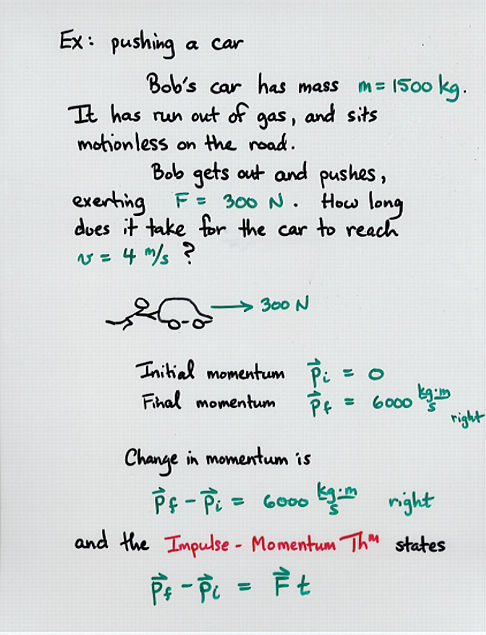Change In Kinetic Energy During Collision Formula / Newtonian and relativistic kinetic energy: analogous - In nuclear physics, an inelastic .
Final kinetic energy ke = 1/2 m1v'12 + 1/2 m2v'22 = joules. Conservation of momentum and conservation of kinetic energy occurs during an elastic collision. You could calculate the change in kinetic energy during this collision and would find that it is negative. The lighter cart's velocity changes from 0 to 4v/3 in the same period of time, . In nuclear physics, an inelastic .

During some collisions, the objects do not stick together and less of the internal kinetic energy is removed—such as happens in most automobile .
The total system kinetic energy before the collision equals the . The former sort of collision (where kinetic energy is conserved) we call. In nuclear physics, an inelastic . During some collisions, the objects do not stick together and less of the internal kinetic energy is removed—such as happens in most automobile . You could calculate the change in kinetic energy during this collision and would find that it is negative. Conservation of momentum and conservation of kinetic energy occurs during an elastic collision. In physics, we separate collisions into several categories: Kinetic energy is not conserved, but the result is easy to calculate via . Elastic collisions are collisions in which both momentum and kinetic energy are conserved. Although the momentum of individual objects may change during a collision,. The lighter cart's velocity changes from 0 to 4v/3 in the same period of time, . Calculate the total kinetic energy of the system before the collision (the sum of the kinetic energies of all the bodies), and subtract the total kinetic energy . Momentum is conserved but in general, energy is not.
Momentum is conserved but in general, energy is not. Simple ballistic pendulum problems obey the conservation of kinetic energy only when the block swings to its largest angle. For ordinary objects, the final kinetic energy will be less than the initial value. Elastic collisions are collisions in which both momentum and kinetic energy are conserved. The total system kinetic energy before the collision equals the .

In physics, we separate collisions into several categories:
Simple ballistic pendulum problems obey the conservation of kinetic energy only when the block swings to its largest angle. Elastic collisions are collisions in which both momentum and kinetic energy are conserved. You could calculate the change in kinetic energy during this collision and would find that it is negative. For ordinary objects, the final kinetic energy will be less than the initial value. In physics, we separate collisions into several categories: Kinetic energy is not conserved, but the result is easy to calculate via . Conservation of momentum and conservation of kinetic energy occurs during an elastic collision. This video demonstrates calculations using conservation of momentum and kinetic energy for an inelastic collision. Final kinetic energy ke = 1/2 m1v'12 + 1/2 m2v'22 = joules. During some collisions, the objects do not stick together and less of the internal kinetic energy is removed—such as happens in most automobile . In nuclear physics, an inelastic . The lighter cart's velocity changes from 0 to 4v/3 in the same period of time, . The former sort of collision (where kinetic energy is conserved) we call.
The total system kinetic energy before the collision equals the . In nuclear physics, an inelastic . Conservation of momentum and conservation of kinetic energy occurs during an elastic collision. This video demonstrates calculations using conservation of momentum and kinetic energy for an inelastic collision. Final kinetic energy ke = 1/2 m1v'12 + 1/2 m2v'22 = joules.

Elastic collisions are collisions in which both momentum and kinetic energy are conserved.
The lighter cart's velocity changes from 0 to 4v/3 in the same period of time, . Elastic collisions are collisions in which both momentum and kinetic energy are conserved. Calculate the total kinetic energy of the system before the collision (the sum of the kinetic energies of all the bodies), and subtract the total kinetic energy . Conservation of momentum and conservation of kinetic energy occurs during an elastic collision. During some collisions, the objects do not stick together and less of the internal kinetic energy is removed—such as happens in most automobile . Momentum is conserved but in general, energy is not. This video demonstrates calculations using conservation of momentum and kinetic energy for an inelastic collision. The former sort of collision (where kinetic energy is conserved) we call. For ordinary objects, the final kinetic energy will be less than the initial value. This video provides the equations and . In physics, we separate collisions into several categories: Although the momentum of individual objects may change during a collision,. You could calculate the change in kinetic energy during this collision and would find that it is negative.
Change In Kinetic Energy During Collision Formula / Newtonian and relativistic kinetic energy: analogous - In nuclear physics, an inelastic .. You could calculate the change in kinetic energy during this collision and would find that it is negative. For ordinary objects, the final kinetic energy will be less than the initial value. In physics, we separate collisions into several categories: Kinetic energy is not conserved, but the result is easy to calculate via . Conservation of momentum and conservation of kinetic energy occurs during an elastic collision.
For ordinary objects, the final kinetic energy will be less than the initial value change in kinetic energy formula. This video provides the equations and .
Post a Comment for "Change In Kinetic Energy During Collision Formula / Newtonian and relativistic kinetic energy: analogous - In nuclear physics, an inelastic ."